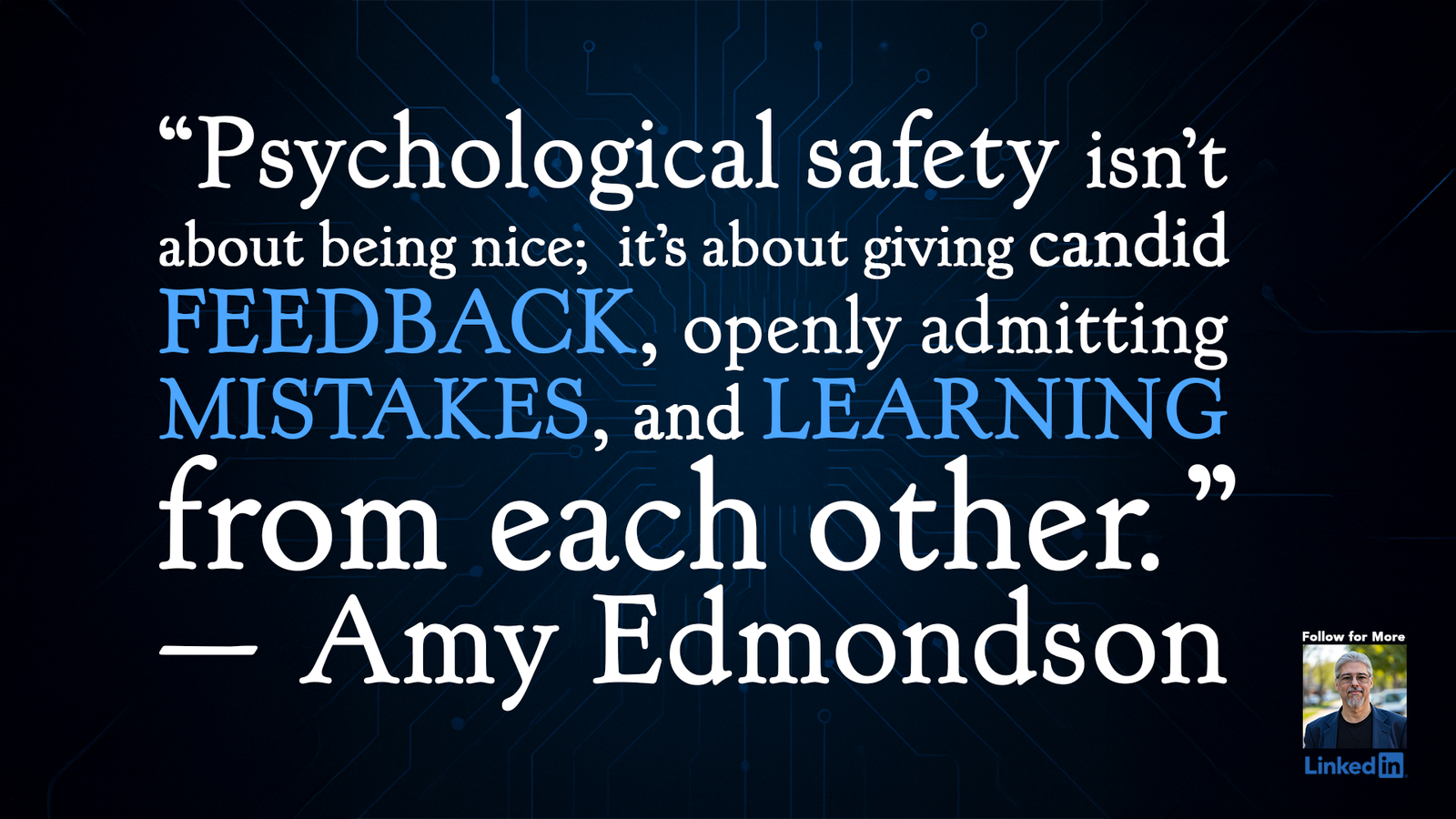Psychological safety is one of the most critical, yet misunderstood, concepts in organizational behavior. At its core, it refers to a team’s shared belief that their environment is safe for interpersonal risk-taking. Harvard professor Amy Edmondson popularized the term, describing it as a workplace where team members feel secure enough to speak up, admit mistakes, ask for help, challenge norms, and respect diverse viewpoints—without fear of embarrassment or retribution.
That environment doesn’t just feel good—it drives performance. When psychological safety is present, communication flows more freely, innovation sparks, and learning accelerates. Teams adapt faster, handle change with more resilience, and ultimately deliver better results.
Why Trust Is the Foundation
Trust is the cornerstone of psychological safety. Without it, “speaking up” feels reckless, not courageous. With it, team members can bring forward new ideas, challenge old assumptions, and collaborate openly. Trust allows people to admit vulnerability without fear of judgment. It transforms risk-taking from something dangerous into something constructive.
In short: trust creates the conditions for teams to thrive.
My Journey with Psychological Safety
My career has been shaped by both the presence and absence of psychological safety. Over seven years, I reported to 14 different leaders while navigating two acquisitions. That level of churn creates instability by itself—but add in a few toxic leaders, and psychological safety evaporates quickly.
Under those leaders, open communication was replaced with guarded silence. Mistakes were hidden instead of shared. Creativity withered. Yet within my own team, I worked hard to cultivate a culture of safety. We thrived despite the turbulence, because inside our circle we trusted each other.
Eventually, though, the stress of working in an unsafe wider culture took its toll. I stepped out of leadership into a technical architecture role, reporting to someone who had once led one of my teams. Because we already had a foundation of trust, I was able to thrive. That season produced some of the most impactful work of my career.
But when that leader moved on, the safety net went with them. My team was offshored, and I was left in an environment where psychological safety no longer existed. I twice turned down director-level opportunities. Without trust and safety, the role and paycheck weren’t worth it. I chose to leave on my own terms.
That experience left me with an unshakable conviction: psychological safety is a leadership choice—and when it’s missing, even the best talent will eventually walk away.
How Leaders Can Build Psychological Safety
The good news is that psychological safety isn’t some abstract ideal. Leaders can cultivate it intentionally. Here are seven practical steps:
- Foster open communication – Encourage people to voice ideas, questions, and concerns without fear of judgment.
- Lead by example – Model vulnerability by sharing your own mistakes. Show that it’s safe to be human.
- Encourage active listening – Go beyond waiting for your turn to speak. Ask clarifying questions. Be curious.
- Provide constructive feedback – Frame feedback as growth, not blame. Invite feedback in return.
- Value diverse perspectives – Inclusion isn’t a slogan—it’s the fuel for creativity and innovation.
- Set clear expectations – Ambiguity breeds anxiety. Clarity builds confidence.
- Address conflicts quickly – Handle issues transparently and fairly to preserve trust.
What Happens When Safety Is Missing
The absence of psychological safety carries steep costs:
- Lack of trust – Teams hesitate to share information or rely on each other.
- Fear of speaking up – Critical insights and concerns go unvoiced.
- Reduced creativity – People stick to safe, incremental ideas rather than risk bold innovation.
- Lower productivity – A tense, fearful environment slows progress.
- High turnover and low morale – Disengagement and dissatisfaction push top performers out the door.
- Missed growth opportunities – Without the space to learn from mistakes, people stagnate.
In short: without psychological safety, talent leaves, innovation stalls, and execution suffers.
Keep Learning and Leading
Building psychological safety is not a one-time initiative. It requires consistency, patience, and genuine leadership. But the payoff is worth it: stronger teams, deeper trust, and sustainable performance.
If you want to dig deeper, I recommend:
- The Fearless Organization by Amy Edmondson — This book provides insights into the importance of psychological safety and offers practical strategies for leaders to cultivate it within their teams.
- Radical Candor by Kim Scott — While not solely focused on psychological safety, this book explores the importance of building trust and fostering open communication within teams.
Both highlight how leaders can create environments where people feel safe, valued, and challenged to grow.
Final Reflection
Psychological safety is not about being “nice.” It’s about building trust, giving candid feedback, admitting mistakes, and learning together. It’s the single greatest predictor of whether a team will just survive—or truly thrive.
Jay Everson – IT Leader & Strategic Innovator with over 25 years in IT, Jay Everson is a highly accomplished professional known for his expertise in IT infrastructure, systems administration, and project management. Jay has led global teams, driven enterprise-level projects, and executed complex acquisitions and integrations. His leadership blends technical proficiency with a hands-on approach, guiding cross-functional teams to success. Recognized for resourcefulness, adaptability, and strategic vision, Jay is a trusted leader in the IT community.





